
Data collection – why does your data collection process matter?
Today, there is more data than ever before. It is growing exponentially, even now as you are reading this article. This means that sports organizations now have access to more insights about their supporters than they could have ever dreamt of.
However, the paradox here is that having too much data at your disposal can become a hassle. Because data is only valuable to you when you can uncover insights from it.
“Data is the new oil. It’s valuable, but if unrefined, it cannot really be used. It has to be changed into gas, plastic, chemicals, etc., to create a valuable entity that drives profitable activity; so must data be broken down, analyzed for it to have value.”
– Clive Humby | British mathematician
Before we dive right in...
Subscribe to our blog today to ensure that you never miss valuable posts such as this one. We are passionate about helping sports organizations deliver a world-class fan experience, because better fan experience means better business. So why not use this opportunity to the fullest?

In order to break down and analyze your data, all you need is to collect it, right? Well, sure, this is true. But there is an obstacle that organizations are faced with. An obstacle that is stopping them from collecting their data in the first place.
So in this blog post, we will be covering:
- What this obstacle is
- What happens if you don’t do something about this obstacle
- How to overcome this obstacle
- And how you can create the ultimate data collection process
So without further ado, let’s jump right in.
The obstacle
Being a savvy sports professional, you are:
- Well aware of the changes digital transformation has given rise to, both in the sports industry and society as a whole.
- You also know that the pandemic has fueled this change.
- And you can see that more and more supporters are changing their behaviors as a result.
For instance, more supporters are choosing to watch games from the comfort of their homes. Moreover, the younger supporter group (AKA Gen Z) prefers to watch game-related content on-demand and interact on other online channels while watching your game (or several games!). In addition, this younger supporter group also expects more from your sports organization. They want to:
- Receive experiences that are tailored to their specific wants and desires
- Have these experiences delivered in all the channels they interact with you in
- Receive these experiences when they want them
Long story short, your supporters want to receive a personal, relevant, and engaging experience when they interact with you.
So what does this mean for your sports organization? Well, it means that you need to first and foremost know enough about your supporters before you can deliver these experiences. In other words, you need the right insights about your supporters. And to have the right insights, you first need the right data.
So what is the problem? Well, that data collection can be limited if…
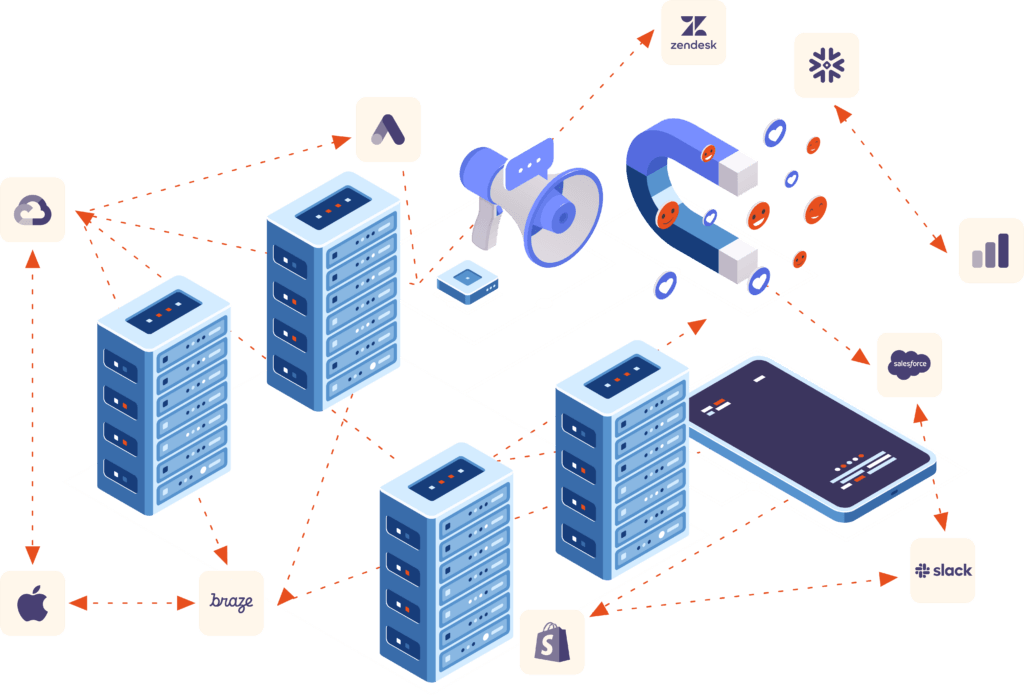
Stored in different sources
Let’s think about this for a moment. If you needed to collect some information about a specific group of supporters right here and now, would you be able to do it? If so, where would you get a hold of this data? What would your data collection process look like? And how long time would this data collection process take?
If you’re finding it hard to answer several of these questions about data collection, then do not fear because you’re far from alone. In fact:
According to Deloitte Digital, the average business has 17 unique technology applications housing customer data.
In other words, your data is most likely scattered across many different sources. For instance, you might have your supporter data stored in:
- Point of Sale (POS) system for food and beverage purchases
- Ticketing system
- Online POS for your merchandise
- App
- OTT streaming service
- Social media platforms
- Members lists
- Newsletter and mailing lists
- Event sign up sheets
As you can imagine, with all these different data sources at your disposal, finding the right data about your supporters can feel like looking for a needle in a haystack.
So what is the solution?
The short answer is: you need to collect all your data in one place.
What happens if you don’t have all your data in one place?
- Your organization wastes time, money, and effort by storing this data in different places because it will be a chore to keep track of it all. And know where to find it when you need it.
- Having scattered and disjointed data means that you don’t really understand the data as a whole.
- This will also lead to blind spots since you don’t really understand the data. And as a result, you risk committing more errors.
- What’s worse, you will miss discovering new and emergent opportunities since your data doesn’t really reveal the true picture. In other words, you don’t have a single source of truth.
Fortunately, the good news is that there is a way for you to stop this cycle once and for all and make your data collection process feel like a walk in the park. And that is by using a Customer Data Platform.
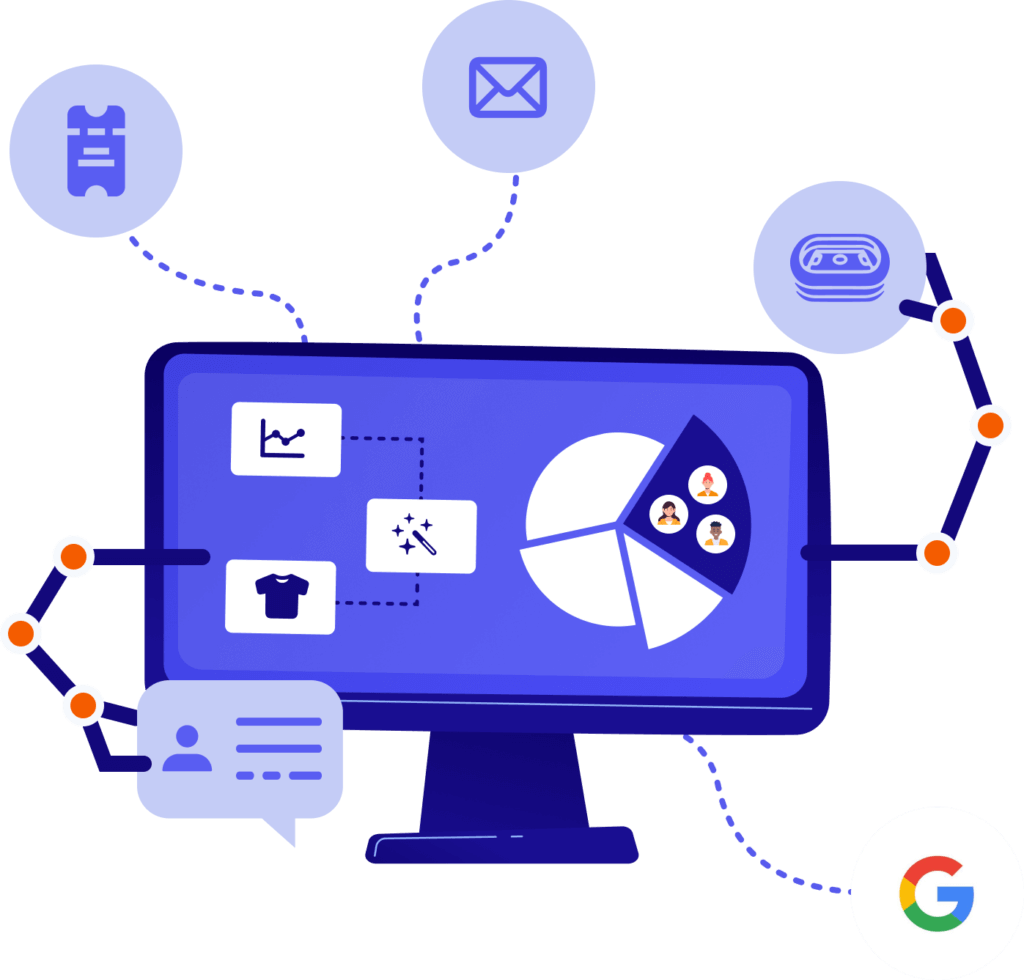
Why a CDP is your best choice for collecting supporter data
Do you know what a Customer Data Platform (CDP) is? It is a software platform that allows you to collect, analyze, and act on your supporter data, ultimately letting you deliver:
- the right message
- to the right supporter
- in their preferred channel
- at the right time
Gone are the days of working with multiple tools and systems. Because with a CDP, you are able to collect and centralize all your data. A CDP is built to handle any type and category of data. It can connect all sources of supporter data, whether internal or external, structured or unstructured, batch or streaming; you can rest assured knowing that you can collect and store it in your CDP.
Here are just some of the types of supporter data you can collect:
- Ticket purchases
- In-stadium purchases
- Stadium entrance data
- Personal data
- Merchandise purchases
- Demographic data
- Web behavior
- Mobile app behavior
and so much more!
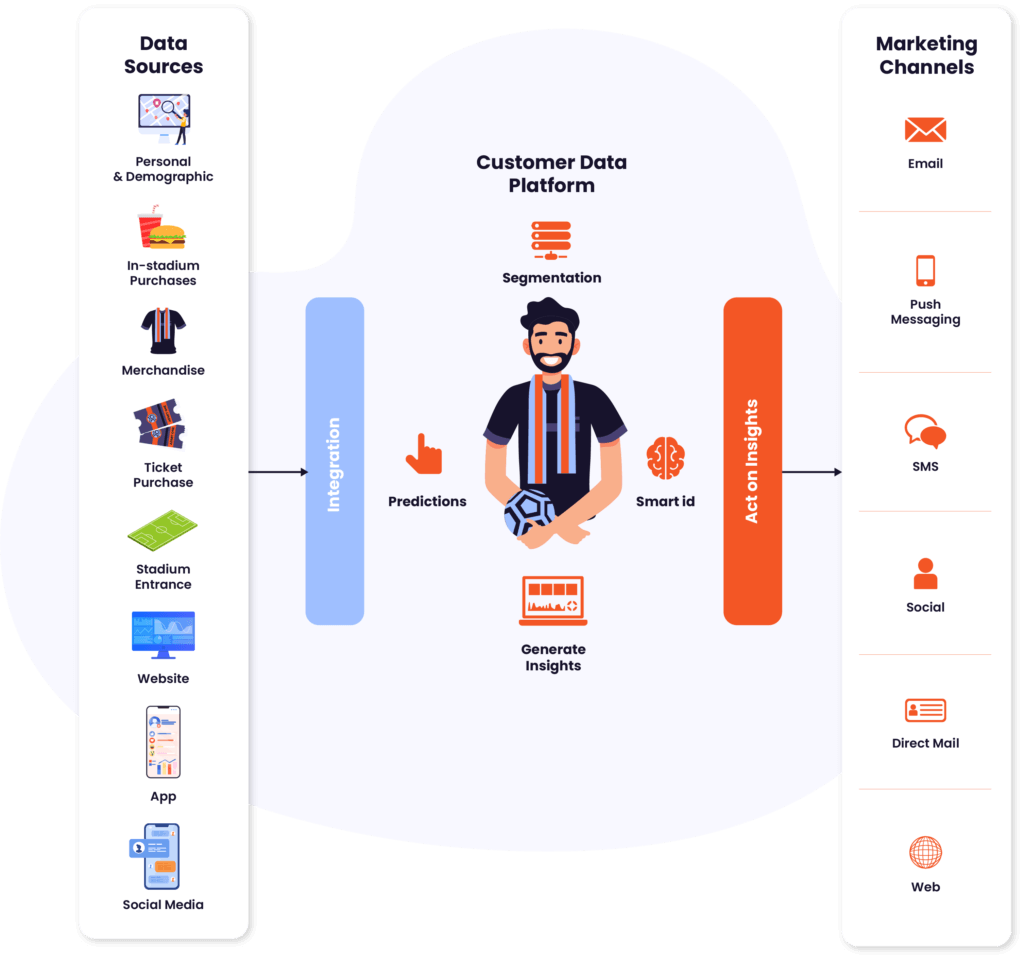

To learn more about why a Customer Data Platform is the best marketing solution out there, check out our article:
Why Sports Organizations need a CDP to grow and thrive >>
To make this more concrete, let’s try to visualize this for a second. Say you have a supporter that:
- Bought tickets to your past three games
- Also bought snacks and beverages at each game
- Signed up for your newsletter
- Follows you on social media
- Subscribed to your OTT-streaming platform
- Downloaded your app
As you can see, there are now several places where you can collect data about your supporter. What a CDP then lets you do is collect all this data and connect it to the specific supporter in question. In other words, this means that a CDP allows you to create:
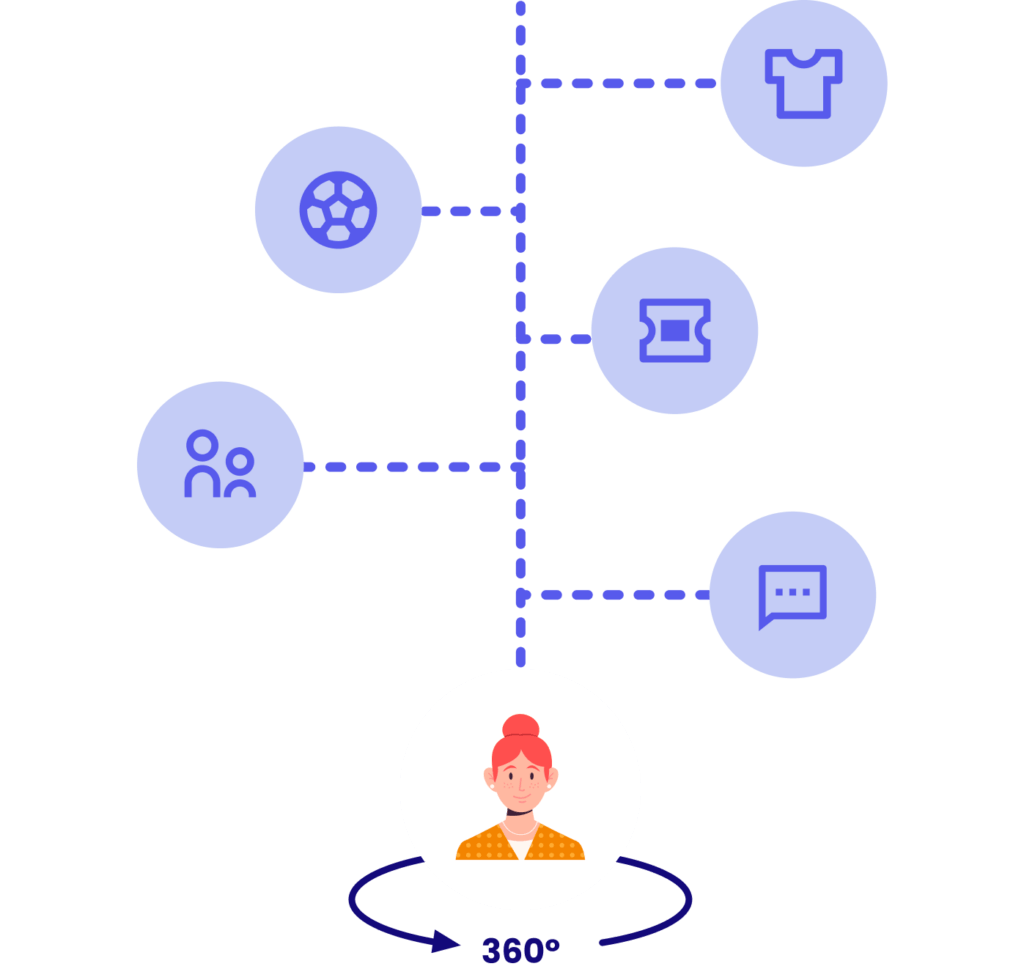
A 360-degree supporter profile
That’s right! By collecting and centralizing all your data into a CDP, you are now able to create a rich and holistic view of each and every supporter. What this means is that, by collecting and unifying all your data, you are able to understand each supporter on a deeper level, such as their specific:
- Characteristics – such as age, gender, geographic location, and family size.
- Preferences – for instance, favorite merchandise products,
- Behaviors – like their ticket purchase frequency, purchase habits
Moreover, the beauty of a CDP is that this all happens in real-time. Specifically, this means that your data is updated the moment something changes, such as your supporter attending a game, buying merchandise from your e-store, or signing up for your newsletter. In other words, your data will always be up to date.
By having these insights about your supporters, you’re then able to act on them in different ways. And this is achieved because now…

…your data is available to everyone that needs it
By collecting and centralizing all of your data in one single place, you are able to share this data with any person, tool, or system that needs it. This means that you receive a single source of truth in your data.
When we say people, we mean, for instance, your colleagues across different teams and departments, certain athletes, your sponsorship partners, or any other individual or entity that you would like to share the data with. This process is known as data democratization. And the amazing thing about data democratization is that you are also enabling more people at your sports organization to feel confident when working with data – irrespective of their technical know-how.
Drive the data democratization in your sports organization while creating an outstanding experience for your supporters
Here are some of the major benefits of data democratization that a Sports CDP will let you enable:
Streamline scattered and siloed supporter data. Organizational data lives in silos, which means that the data is held somewhere which is not easily or fully accessible to other teams. This is usually due to reasons concerning:
- Security
- Stability
- Data governance
Consequently, this makes it impossible to build unified and detailed supporter profiles. Wouldn’t it be great to finally get away from your spreadsheet hell and work in a robust & structured way?
Map out non-linear supporter journeys. Linear supporter journeys no longer exist. Today, supporters don’t only expect to receive a world-class supporter experience inside the stadium. They also expect to receive this same experience outside of the stadium across all channels that they choose to interact with your sports organization in, which is why measuring cross-device touchpoints matters. Bring together online and offline data, offering them an experience that they will never forget. Examples of such touchpoints could be:
- In stadium
- Website
- Mobile app
- Online merchandise store
- OTT platform
- Social media channels
- Email newsletters
- Membership platform
Embrace data-driven sports marketing. There is no excuse for not knowing what your supporters need and desire. As we have covered previously, having data from multiple sources will help you be more relevant in your communications and interactions that you have with your supporters. When you have a Sports CDP in place, you will reive a unified view of each supporter, enabling you to deliver communications and interactions that are:
- personalized
- relevant
- engaging
…across all channels and touchpoints in which your supporters interact with you in.
Faster and more accurate decision-making. As a sports marketer, your goal is to make sense of your data and use these insights to make timely decisions that serve your fans and supporters. After all, you don’t want to just report on results but actually act on them as well, right?
As you can see, by collecting and unifying your supporter data, you are now able to:
- Get a rich 360-degree view of each and every supporter. Because in order to give your supporters what they want and desire, you need to know your supporters better than they know themselves.
- Deliver experiences to your supporters that are personalized, consistent, and seamless across all channels and platforms in which they interact with you in.
- By unifying your data using a Sports CDP, you are also enabling everyone at your sports organization to work more data-driven – AKA data democratization.
Okay, so now that you know why a Sports CDP is key to creating the optimal data collection process and we also know what benefits you can reap using a CDP, it’s now time to look at how you can achieve implement this data collection process right here and now.
How to collect data in the best and easiest way possible [using the Data Talks Sports CDP]
Alright, now we have learned what the biggest obstacle is that sports organizations face in their data collection process. We have also covered why the data collection process is crucial and why a Sports CDP is your best choice. So now, it’s time for us to look at what this data collection process looks like in action – using the Data Talks Sports CDP.
We know that one size does not fit all. That is why we have defined a smooth and fast process that will help you bring all of your scattered data sources together with minimum effort.
So here are the steps we take to collect and unify your data – so you can start leveraging quickly and efficiently.

Step 1 – Map out your data sources
The first step when collecting your data into the Sports CDP is to identify which data you want to stitch together. Remember that you can choose any type of data, no matter if it comes from an online or offline source.
To help you get started, here are a few data sources that you most likely have in place:
- Ticketing system
- Point of Sale (POS) system for food and beverage purchases
- Online POS or e-commerce store for your merchandise
- App
- OTT streaming service
- Social media platforms
- Membership lists
- Newsletter and mailing lists
- Event sign up sheets
Once you have identified and mapped out your different data sources, it’s time to define your use cases.
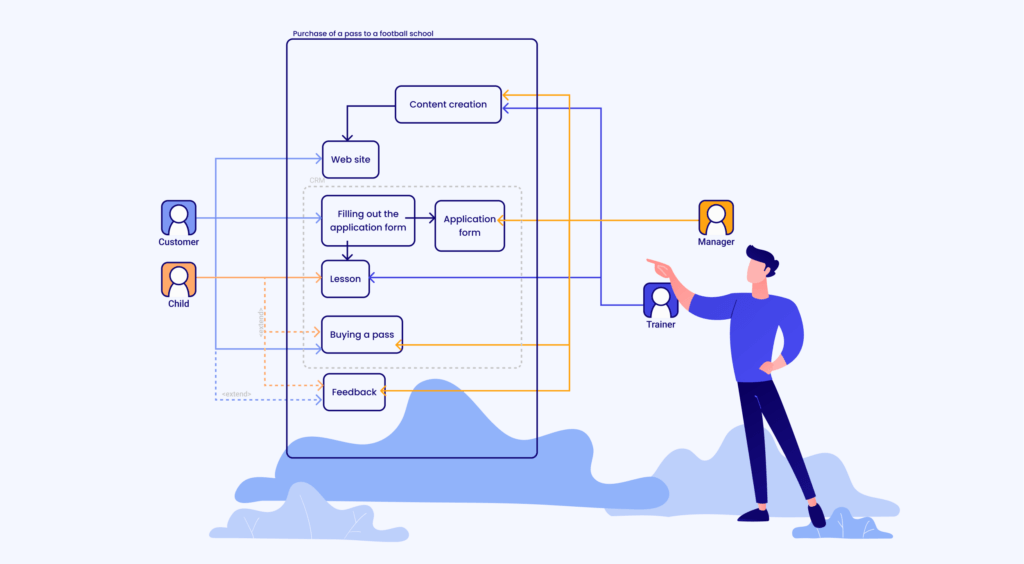
Step 2 – Define your use cases
Now that you know which data sources you would like to unify, the next question you should ask yourself is: what exactly do I want to achieve by doing this? Specifically, you want to articulate and design what you are actually going to do with this data once you have gathered it.
When you work with Data Talks, we will, of course, help you identify and define your use cases. But to give you an idea of what is possible, here are a few examples:
- Increase your ticket sales
- Boost sponsorship value increase in-stadium purchases, such as sales of food and beverages.
- Leverage your OTT-platform
- Increase supporter engagement and loyalty
- Boost merchandise sales in your e-store
- Increase your supporter lifetime value
- Create new revenue streams
Then once you have decided on your use cases, the next step is to define your goals, AKA key performance indicators (KPIs). The reason why you should care about KPIs is that they are crucial to measuring the success of your different use cases.

Learn everything you need to know about defining and measuring KPIs in a Sports CDP in this article >>
Long story short, defining use cases and setting clear goals (KPIs) from the get-go will help you see what value you can achieve when using a Sports CDP.

Step 3 – Data collection and integration
Finally, now that you have defined your use cases and the KPIs you will use to measure the success of each use case, it’s time to get started with collecting and integrating your data. In this third and final step, you can rest assured knowing that our experienced developers will set up the integrations in cooperation with your team in a fast, secure & GDPR-compliant environment. And before you know it, the CDP will be up and running in no time.
Once you have integrated all your data, you can sit back and relax and tick off the following list:
- The Data Talks Sports CDP can collect data from any source
- It can capture all details from the collected data
- Store this collected data indefinitely (subject to privacy constraints)
- Create unified profiles of identified individuals
- You can share your data with any third-party tool or system that needs it
And do you know what the best part is? That the list that we have presented above not only defines what you will be able to achieve. It is also the criteria that the CDP Institute has created to determine whether a CDP fulfills the criteria for being a real CDP.
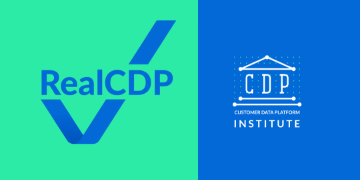
Data Talks CDP is proudly a certified CDP
Conclusion
In this article, you have learned:
- That the biggest obstacle sports organizations face in their data collection is that their data is scattered across many different data sources.
- And when your data is not stored in one place, it means that you are not able to unlock the value hiding in that data – which basically means you are leaving money on the table.
- But by using a customer data platform, you remove this obstacle and instead leverage your data to the fullest extent – no matter whether it is online or offline data from any data source that you would like to integrate.
- And you have also learned how to put together the best data collection process possible using the Data Talks Sports CDP.
But we want to take this one step further. So to show you the true power of the Data Talks Sports CDP, we have created a free demo for you to explore here and now. After all, a picture is worth more than a thousand words, right?
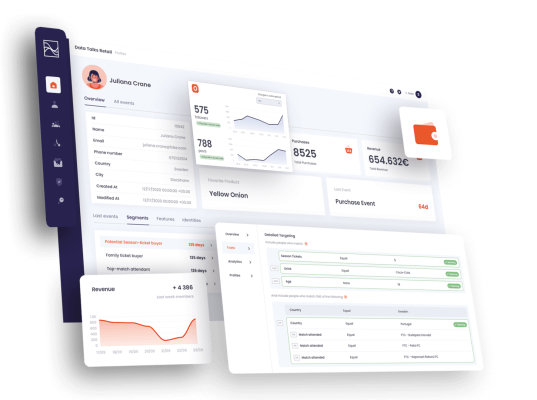
Leave a Reply